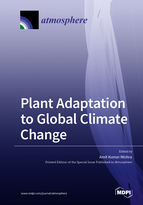Plant Adaptation to Global Climate Change
A special issue of Atmosphere (ISSN 2073-4433). This special issue belongs to the section "Biometeorology".
Deadline for manuscript submissions: closed (21 August 2020) | Viewed by 51319
Special Issue Editor
Special Issue Information
Dear Colleagues,
Plants vary in their response to the changing environment. This has a high impact on agriculture, especially because of the need to produce more food for the rapidly growing population, using suboptimal growth conditions because of lesser availability of resources like water on one hand, and global warming on the other hand. Crop production is susceptible to climate variability, and climate change related with high temperature, elevated CO2, varying patterns of rainfall, and other environmental factors are having an adverse impact on global crop production and food security. The influence of climate change on plants may be from cellular to the molecular level. Subsequently, the existing literature on the plant’s response to different environmental stresses is diverse. In view of the future impacts of climate change, understanding the response of plants becomes critical in developing strategies to cope with the threats to plant growth and development.
This Special Issue will focus in particular on the current research of effects of air pollutants, UV-B, salinity, heat/freeze, drought, and other environmental factors on plants. We encourage the submission of the manuscripts that include plant–environment interaction and particularly welcome those studies that aim to integrate morphological, physiological, biochemical, and molecular approaches of plant response to climate change.
Dr. Amit Kumar Mishra
Guest Editor
Manuscript Submission Information
Manuscripts should be submitted online at www.mdpi.com by registering and logging in to this website. Once you are registered, click here to go to the submission form. Manuscripts can be submitted until the deadline. All submissions that pass pre-check are peer-reviewed. Accepted papers will be published continuously in the journal (as soon as accepted) and will be listed together on the special issue website. Research articles, review articles as well as short communications are invited. For planned papers, a title and short abstract (about 100 words) can be sent to the Editorial Office for announcement on this website.
Submitted manuscripts should not have been published previously, nor be under consideration for publication elsewhere (except conference proceedings papers). All manuscripts are thoroughly refereed through a single-blind peer-review process. A guide for authors and other relevant information for submission of manuscripts is available on the Instructions for Authors page. Atmosphere is an international peer-reviewed open access monthly journal published by MDPI.
Please visit the Instructions for Authors page before submitting a manuscript. The Article Processing Charge (APC) for publication in this open access journal is 2400 CHF (Swiss Francs). Submitted papers should be well formatted and use good English. Authors may use MDPI's English editing service prior to publication or during author revisions.
Keywords
- Air Pollution
- Plant–environment interaction
- Environmental stress
- UV-B and plant response
- Abiotic stress and plant response
- Light sensing and mechanism






